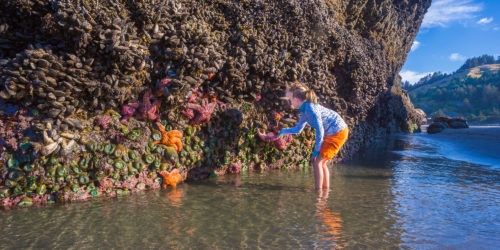
Photo courtesy of Outdoor Project
This article is provided courtesy of the U.S. Forest Service.
The coastal population of the western snowy plover (Charadrius alexandrinus nivosus) was listed as a threatened species by the U.S. Fish and Wildlife Service in 1993. In 2007, the U.S. Fish and Wildlife Service completed a cooperative plan for recovery of the Pacific Coast population of the western snowy plover. The western snowy plover spends its entire life on the beaches of Washington, Oregon, California, and the Baja peninsula. The population in Oregon has ranged from 72 to 208 adults since 1993.
The Siuslaw National Forest is an active partner in a strong collaborative stewardship approach to protecting western snowy plover breeding and nesting habitat, educating ocean shore visitors, monitoring reproductive success, and public compliance.
Of the eight nesting sites in Oregon, five occur on the Siuslaw National Forest and the Oregon Dunes National Recreation Area. Seasonal restrictions within Snowy Plover Management Areas are enacted in partnership with the Oregon Parks and Recreation Department. Each year, the forest installs signs and site specific information, builds nesting exclosures.
What Does Nesting Season Mean for Beachgoers?
During the breeding season between March 15 and September 15 dry sand beach areas are closed to human entry to help protect the plovers during the critical nesting season. Snowy plovers lay their eggs in small depressions on open sand. If the birds are disturbed by people or pets, they may fly away from their nest, putting their eggs or young at risk.
In order to protect known nesting areas, it is important for beachgoers to pay attention to signs identifying what types of beach activities are permitted and what areas are open. Different restrictions apply to dry and wet sand and open and closed areas. Closed areas around nesting areas on the Siuslaw National Forest are clearly marked.
Protecting the Western Snowy Plover Project Goals
- Conserve and recover Western Snowy plover populations in nesting sites occurring on and adjacent to the Forest and Oregon Dunes National Recreation Area.
- Strengthen and develop partnerships with organizations and individuals who will participate in restoring western snowy plover habitat and populations.
- Increase public awareness of the broader, long-term significance of recovery efforts, thereby increasing public compliance to local restrictions.
Project Status
2012 survey and monitoring of the distribution and reproductive success of the western snowy plover along the Oregon Coast indicated the highest estimate of adult plover population and highest number of nests since monitoring began in 1990.
What Can You Do to Help?
- Your vehicle, dog, and even kite may be enough to put eggs and young birds at risk. Make sure you know where the dog-friendly beaches are during nesting season.
- Your trash may attract predators like ravens and crows to the area, where they may make a meal out of a plover egg.
- Please respect the beach restrictions in nesting areas and read all posted signs carefully.
- Enjoy beach activities in areas that are not home to the snowy plover.
Know Before You Go
Many Oregon beaches are not used by the birds, and visitors can enjoy a wide range of activities there year round. On other beaches, designated as plover nesting beaches, certain activities are limited from March 15 through September 15.
Visitors should pay attention to signs identifying what types of beach activities are permitted and what areas are open. Different rules apply to dry and wet sand on plover beaches. Designated trails that go through plover areas remain open. Users must remain on the trail, and once on the beach, walk on wet sand that is close to the water’s edge.
Where Are The Restrictions?
- Oregon Dunes Day Use Area
- Siltcoos Estuary and Surrounding Area
- Spinreel to Horsfall Area
- Tahkenitch Creek Estuary and Surrounding
- Umpqua Dunes Area (Winchester Bay Area)
- Ten Mile Creek Estuary and Surrounding Area
- Baker Beach and Sutton Area
Plover Partners
- Partnerships with other agencies and organizations are central to the success of this project. Learn more about partnership efforts in the western snowy plover recovery effort from the following partners:
- Oregon Parks and Recreation Department: Western Snowy Plover and the Oregon Coast
- Oregon Fish and Wildlife Office: Western Snowy Plover
For More Information
Visit the U.S. Fish and Wildlife Service Western Snowy Plover page.
See detailed information about seasonal restrictions on Siuslaw National Forest here.



